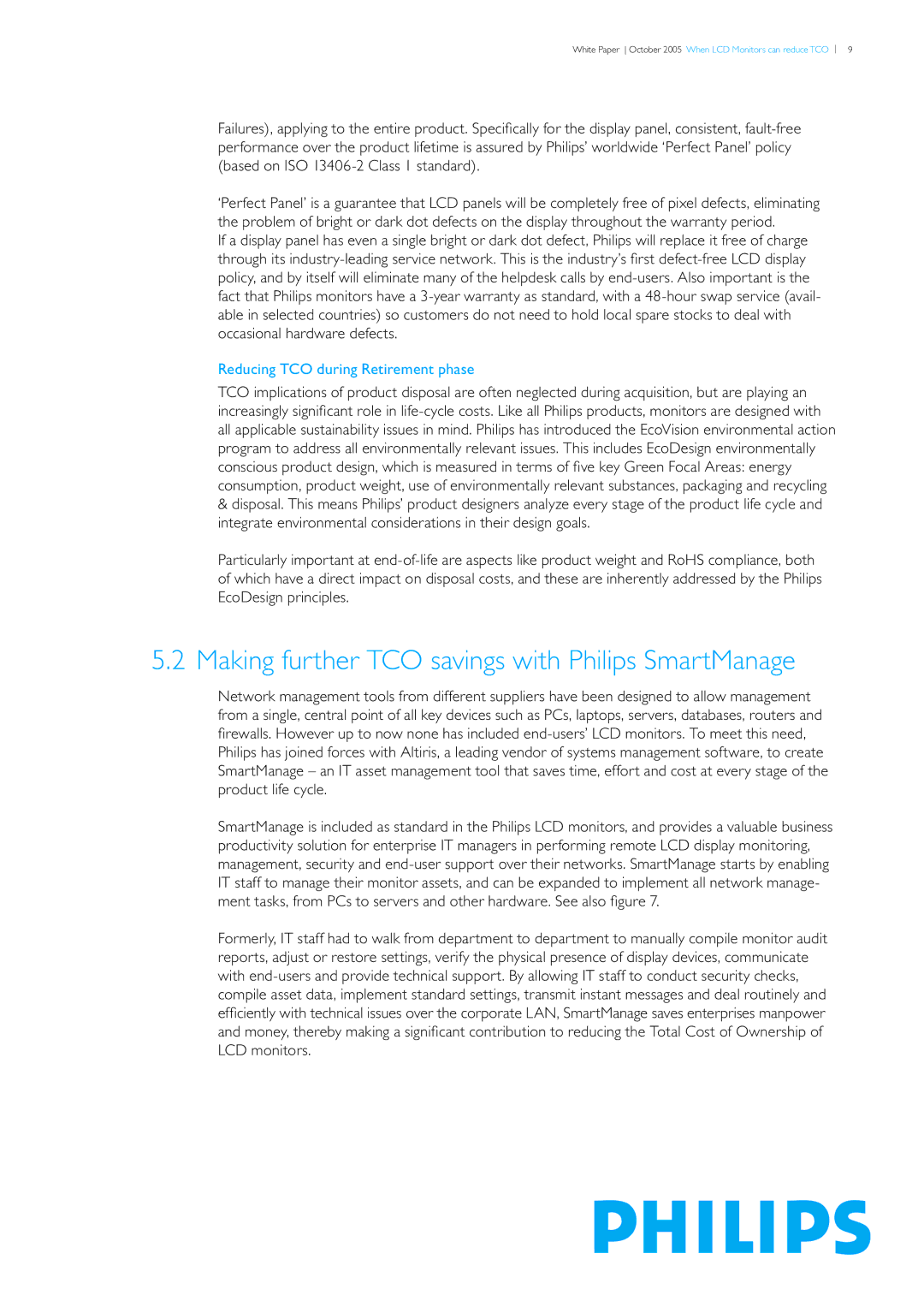White Paper October 2005 When LCD Monitors can reduce TCO 9
Failures), applying to the entire product. Specifically for the display panel, consistent, fault-free performance over the product lifetime is assured by Philips’ worldwide ‘Perfect Panel’ policy (based on ISO 13406-2 Class 1 standard).
‘Perfect Panel’ is a guarantee that LCD panels will be completely free of pixel defects, eliminating the problem of bright or dark dot defects on the display throughout the warranty period.
If a display panel has even a single bright or dark dot defect, Philips will replace it free of charge through its industry-leading service network. This is the industry’s first defect-free LCD display policy, and by itself will eliminate many of the helpdesk calls by end-users. Also important is the fact that Philips monitors have a 3-year warranty as standard, with a 48-hour swap service (avail- able in selected countries) so customers do not need to hold local spare stocks to deal with occasional hardware defects.
Reducing TCO during Retirement phase
TCO implications of product disposal are often neglected during acquisition, but are playing an increasingly significant role in life-cycle costs. Like all Philips products, monitors are designed with all applicable sustainability issues in mind. Philips has introduced the EcoVision environmental action program to address all environmentally relevant issues. This includes EcoDesign environmentally conscious product design, which is measured in terms of five key Green Focal Areas: energy consumption, product weight, use of environmentally relevant substances, packaging and recycling
&disposal. This means Philips’ product designers analyze every stage of the product life cycle and integrate environmental considerations in their design goals.
Particularly important at end-of-life are aspects like product weight and RoHS compliance, both of which have a direct impact on disposal costs, and these are inherently addressed by the Philips EcoDesign principles.
5.2 Making further TCO savings with Philips SmartManage
Network management tools from different suppliers have been designed to allow management from a single, central point of all key devices such as PCs, laptops, servers, databases, routers and firewalls. However up to now none has included end-users’ LCD monitors. To meet this need, Philips has joined forces with Altiris, a leading vendor of systems management software, to create SmartManage – an IT asset management tool that saves time, effort and cost at every stage of the product life cycle.
SmartManage is included as standard in the Philips LCD monitors, and provides a valuable business productivity solution for enterprise IT managers in performing remote LCD display monitoring, management, security and end-user support over their networks. SmartManage starts by enabling IT staff to manage their monitor assets, and can be expanded to implement all network manage- ment tasks, from PCs to servers and other hardware. See also figure 7.
Formerly, IT staff had to walk from department to department to manually compile monitor audit reports, adjust or restore settings, verify the physical presence of display devices, communicate with end-users and provide technical support. By allowing IT staff to conduct security checks, compile asset data, implement standard settings, transmit instant messages and deal routinely and efficiently with technical issues over the corporate LAN, SmartManage saves enterprises manpower and money, thereby making a significant contribution to reducing the Total Cost of Ownership of LCD monitors.
